My Mum, the Nurse.
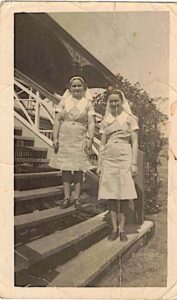
Jean (Rene) and her friend Ella, Student Nurses at Mt. Morgan Hospital. Authors collection.
“Tip it in! Tip it in!” This was the ditty that my mum, trainee nurse Rene Morris, sang with her fellow trainee nurse friend, Ella, as they emptied their patients’ pans as part of their nursing duties at Mount Morgan Hospital in central Queensland. Being a trainee nurse in the late 1930s and early 1940s was arduous, so friends and fun were essential components for survival and completing the rigorous training.
Rene, born in 1919 in Mount Morgan, was a trainee nurse for four years, commencing just before the outbreak of the Second World War. The general nursing training for a small hospital, such as Mount Morgan, was longer, with at least yearly exams before a nurse could register as a trained nurse.
To become a nurse in Queensland at the time, prospective probationers were required to have a minimum of grade five primary school education, although grade six was preferred; this low education requirement remained in place until 1968. Most Queensland girls did not attain this level of education, as girls’ education was not considered a priority at the time. Only a minimum education was thought necessary for girls, as they were expected to marry and leave paid work.[1]
Rene easily met the minimum education criterion. Jean Irene, known as Rene was the third child of John and Margaret Morris, who had eight children, but Rene was considered clever by her parents, and she was allowed to continue her education until she sat for the Junior Public Examination in November 1935. Rene was lucky, as Mount Morgan had one of the earliest public high schools in Queensland, and she continued her education until she sat for the Junior examination. She performed well in the examination, earning two As in English History and Algebra, and two Bs in Geography and Arithmetic, along with three Cs.[2]
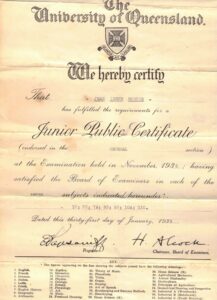 With her good examination results, but her dream of being a teacher unattainable, Rene, aged sixteen, took on temporary jobs. One day, her father visited her and informed her that he had enrolled her as a trainee nurse at Mount Morgan Hospital. Her Junior results would have made her a well-educated applicant. Armed with a pair of brown lace-up shoes, she embarked on her nursing career. Nursing was not her yearned-for teaching career, but it was one of the few acceptable professions for women.
With her good examination results, but her dream of being a teacher unattainable, Rene, aged sixteen, took on temporary jobs. One day, her father visited her and informed her that he had enrolled her as a trainee nurse at Mount Morgan Hospital. Her Junior results would have made her a well-educated applicant. Armed with a pair of brown lace-up shoes, she embarked on her nursing career. Nursing was not her yearned-for teaching career, but it was one of the few acceptable professions for women.
Rene commenced her training in the late 1930s, when the country was emerging from a long depression. Trainee nurses received low pay and endured poor working conditions. The nursing hierarchy required obedience and dedication from trainee nurses, particularly in relation to matrons, home sisters, and other senior nurses. Nurses lived in at their training hospital, although the accommodation was often poor. A 1937 award variation provided for the continuation of 96 hours of work per fortnight for trainees, although hospital domestics had their working hours reduced to 44 hours per week in this award. Trainee nurses were also required to attend lectures, which were often held outside their regular working hours. And when the nurses exceeded their regulated working hours per fortnight, they rarely received overtime pay.
Nursing at this time was hard, heavy work. Nurses constantly cared for patients, lifting and turning them without the equipment available today. They also had to cook special meals for invalids. Penicillin was discovered in 1939 but was not available in Queensland as late as 1944.[3] Good and careful nursing was often responsible for a patient’s survival, not the modern wonder drugs of today.
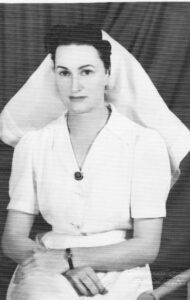
Rene in her nurses uniform having graduated. Authors collection.
Rene completed her training and was registered as a general nurse on 29 January 1943, and she was entitled to wear the starched white veil of a trained nurse. Her graduation was during the Second World War, and the war had altered Australia’s view of women in the workforce. With Australia considered under threat from the Japanese, the government introduced Manpower Regulations. From February 1943, all trained nurses were required to register with the Manpower Directorate. Nurses not working in the profession were investigated. A significant nursing shortage existed at this time, and the enlistment of registered nurses in the military was considered a contributing factor to this shortage.
From 1940, Australia had a shortage of nurses, particularly in midwifery and child welfare. With a shortage of midwives, Rene continued her education and trained as a midwife at Rockhampton’s Lady Goodwin Maternity Hospital. She was registered as a midwife in December 1943, having completed six months of training. By late 1943 the Manpower Directorate appointed Rene to the Barcaldine Hospital as she was a double-certificated nurse.[4]However within a month, she had decided that Barcaldine was not for her and departed by train.[5]
Many Australian nurses enlisted in the military as part of their war effort. Rene attempted to enlist, but the military recruitment services did not accept her. She was a midwife and was required for home services. I am aware of at least one other double-certificated nurse whose enlistment was also not accepted. Apparently, this was unofficial policy. The various authorities determined Rene’s future. She was required for home service as a midwife despite her not liking midwifery.
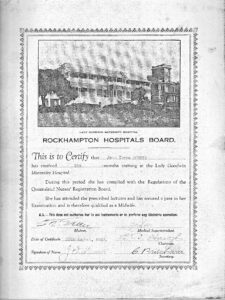
Midwifery Certificate of Jean Irene (Rene) Morris, 25 August 1943. Authors collection.
Ayr Hospital in northern Queensland was where Rene was next appointed. Ayr in north Queensland was closer to the war, with the Japanese bombing nearby Townsville. But Rene and her nursing colleagues worked collaboratively, supporting each other, particularly when a nurse’s relative was being posted north for military service. Many military personnel were stationed in Townsville, including those from the United States. Ayr was a recreational destination for Townsville troops, and they would travel by truck to Saturday dances in the sugar town. Historian Margaret Bevege, who undertook a field study, identified that relations between the American and Australian troops were generally good.[6]
Rene remained in Ayr until after the war ended and her time in Ayr was relatively pleasant. Being relieved that the war had ended, Rene’s next career step was a move to Brisbane where she was appointed Senior Sister at St Helen’s Methodist Hospital. Rene was proud of her profession and her position, and she remained at St. Helen’s until her 1952 wedding to Robert James Kenneth (Ken) Porter. Rene and Ken moved to Dalby and Warwick with Ken’s work, where he was the manager at Cobb and Co depots in those towns. A chilly Warwick was new to Rene who worked as a sister in the children’s ward of Warwick Hospital, where she walked to work in the cold. And soon developed chilblains after sitting beside the ward’s fire and reading the night report. Rene’s nursing career ended when she and Ken moved to Brisbane.
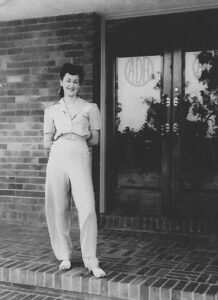
Rene Morris at Ayr Hospital, Queensland. Authors collection.
Many years later, I asked Mum why she didn’t continue to work as a nurse after returning to Brisbane. She said that she did not believe she could give nursing all the attention required when she was also a wife and mother. Rene was proud to be a nurse and always gave her profession her full attention. Perhaps her father was correct in enrolling her in nursing training school.
[1] Glenda Strachan, Labour of Love: The History of the Nurses’ Association in Queensland 1860-1950, Allen & Unwin, St Leonards, NSW, 1996, p. 45.
[2] Junior Certificate for Jean Irene Morris, The University of Queensland, Brisbane, 31 January 1936, original held by Margaret Doherty.
[3] John Pearn, Focus and Innovation: A History of Paediatric Education in Queensland, Department of Child Health, University of Queensland, 1966, p. 47.
[4] ‘Barcaldine’, Morning Bulletin, Rockhampton, 30 October 1943, p. 4.
[5] ‘Barcaldine Personnel’, Longreach Leader, 14 November 1943, p. 14.
[6] Margaret Bevege, ‘In North Queensland in World War II’, in Worth Her Salt: Women at Work in Australia, ed. Margaret Bevege, Margaret James and Carmel Schute, Sydney, Hale & Iremonger, 1982, pp. 103-104.

How things have changed for women! My mother lived her whole life believing that married women shouldn’t work. She was born in 1924 and had to give up her job when she married in 1944.
Fleur, Mum didn’t work after I was born
Thanks Marg. As I read this, I couldn’t help but think about differences between then and now: from educational requirements to the amount of physicality required and the responsibility of today’s nurses with regard to the many drugs they are responsible for administering. Our world has changed so much in the last 100 years.
A lovely tribute to your mum, Marg. Pauline
Beautiful memories of your mother and your family history,
Mary, I am very proud of what she achieved.